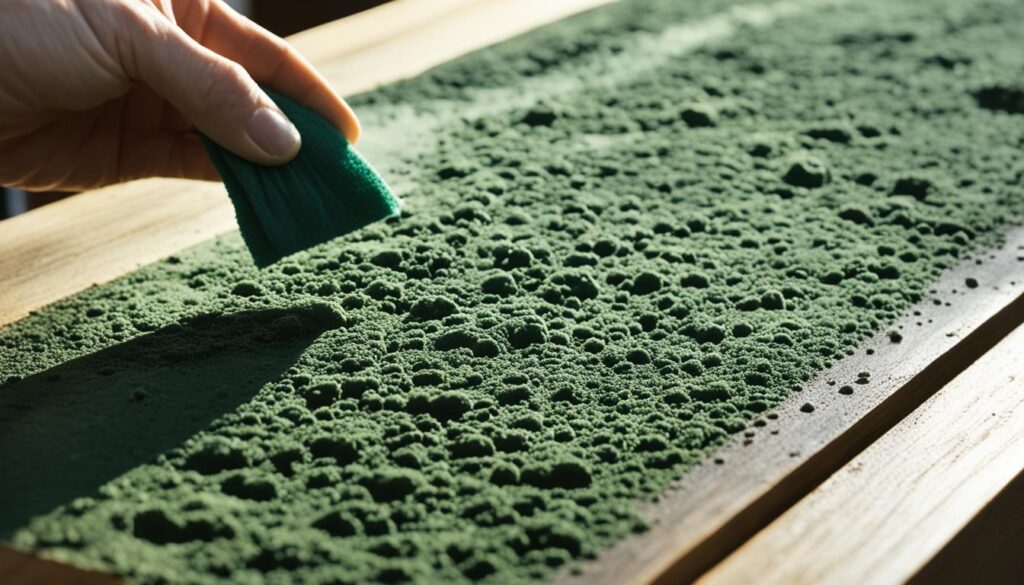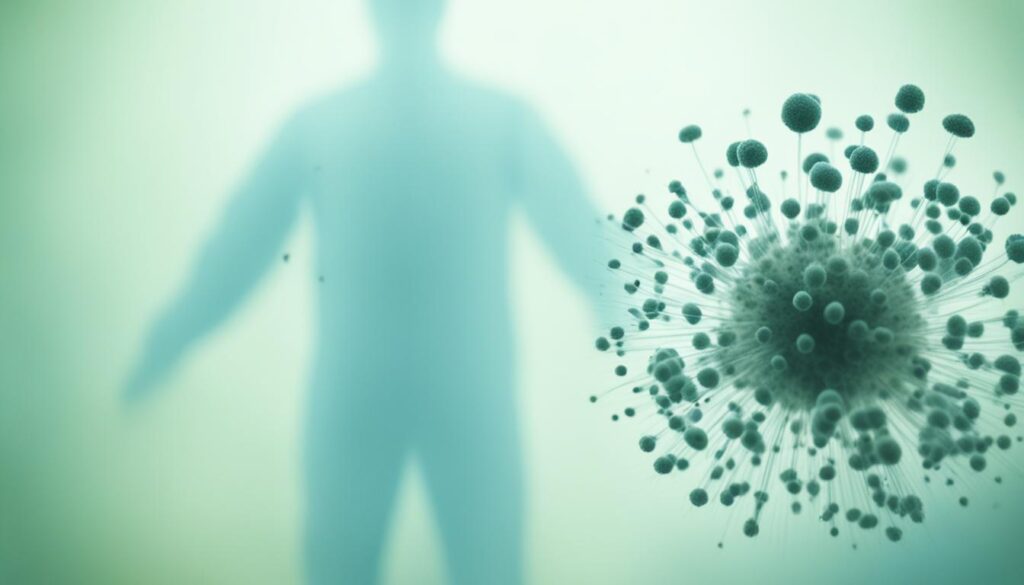
Understanding Penicillium Mold Exposure & Risks
Penicillium mold is a common household mold that can have serious health implications if left unaddressed. Exposure to Penicillium mold can lead to various respiratory issues and allergies, making it crucial to understand the risks associated with it. In this section, we will provide a comprehensive overview of Penicillium mold, its potential for exposure, and the health risks it poses.
Key Takeaways:
- Penicillium mold is a common type of household mold.
- Exposure to Penicillium mold can lead to respiratory problems and allergies.
- Understanding and mitigating Penicillium mold is crucial for maintaining a safe living environment.
- Cleaning mold off wood surfaces requires effective methods and recommended cleaning products.
- Preventing and mitigating Penicillium mold exposure involves controlling moisture levels and improving ventilation.
How to Clean Mold off Wood
When it comes to mold growth, wood surfaces are particularly vulnerable. Whether it’s furniture, flooring, or other wooden materials in your home, it’s crucial to address mold promptly to prevent further damage and potential health risks. In this section, we will provide you with effective methods to clean mold off wood, ensuring a safe and mold-free environment.
Step-by-Step Mold Removal Process
Follow these steps to safely and efficiently remove mold from wood surfaces:
- Prepare the area: Begin by wearing protective gear such as gloves, goggles, and a respiratory mask to avoid direct contact with mold spores. Open windows or use fans for ventilation.
- Isolate the affected area: Use plastic sheets or tarps to isolate the mold-infested wood, preventing the potential spread of spores to unaffected areas.
- Scrub the surface: Using a stiff brush or scrubbing pad, gently scrub the moldy wood surface to loosen and remove the mold. Be sure to brush along the grain of the wood.
- Clean with a mold cleaner: Apply a commercial mold cleaner or a solution of one-part bleach to ten parts water. Thoroughly scrub the wood surface using the chosen cleaner, ensuring complete coverage.
- Rinse the area: After cleaning, rinse the wood surface with clean water and a sponge or cloth to remove any remaining mold cleaner or bleach solution.
- Dry the wood: Use fans or dehumidifiers to dry the wood thoroughly. It is crucial to eliminate excess moisture to prevent future mold growth.
- Monitor for mold regrowth: Regularly inspect the treated area for any signs of mold regrowth. If mold reappears, repeat the cleaning process or consult a professional mold remediation service.
Note: It is important to follow the manufacturer’s instructions when using commercial mold cleaners or bleach solutions. Always test a small, inconspicuous area of the wood surface before applying the cleaner or bleach to ensure it does not cause discoloration or damage.
Recommended Cleaning Products
Here are some effective cleaning products that can help you clean mold off wood:
- Vinegar: A natural and non-toxic cleaner, vinegar can effectively kill mold on wood surfaces. Mix equal parts white vinegar and water and use it to clean the mold-infested wood.
- Borax: Borax is a powerful mold killer. Mix one cup of borax with one gallon of water and use the solution to scrub the moldy wood. Rinse thoroughly after cleaning.
- Hydrogen peroxide: Hydrogen peroxide can effectively kill mold and remove stains. Use a spray bottle to apply a 3% concentration of hydrogen peroxide directly onto the moldy wood. Allow it to sit for 10 minutes before wiping clean.
- Mold and mildew remover: Commercial mold and mildew removers are readily available and can be effective in removing mold from wood surfaces. Be sure to choose a product specifically designed for use on wood.
By following these step-by-step instructions and using the recommended cleaning products, you can efficiently clean mold off wood surfaces and maintain a healthy living environment.

Mitigating Penicillium Exposure
To protect yourself and your family from Penicillium mold exposure, it is crucial to implement effective prevention and mitigation strategies. By controlling moisture levels, improving ventilation, and practicing proper maintenance, you can minimize the growth of Penicillium mold in your home.
Controlling Moisture Levels
Excess moisture provides the perfect environment for Penicillium mold to thrive. Here are some tips to control moisture:
- Repair any leaks in pipes, roofs, or windows to prevent water intrusion.
- Ensure proper drainage around the foundation of your home.
- Use exhaust fans in high-moisture areas such as bathrooms and kitchens.
- Regularly clean and maintain air conditioning units and dehumidifiers.
- Avoid overwatering plants and ensure proper ventilation in indoor gardens.
Improving Ventilation
Good air circulation helps reduce humidity levels and prevent mold growth. Follow these ventilation tips:
- Open windows and doors regularly to allow fresh air to flow through your home.
- Use fans to increase airflow in enclosed spaces.
- Install vent fans in bathrooms, laundry rooms, and kitchens to remove excess moisture.
- Clean and maintain air vents and ducts to ensure proper ventilation.
Implementing Proper Maintenance
Maintaining a clean and well-maintained home is essential for preventing Penicillium mold growth. Consider the following recommendations:
- Regularly clean and dust your home to remove potential mold spores.
- Inspect and repair any areas with water damage, such as roofs, walls, or flooring.
- Ensure proper insulation to prevent condensation and moisture buildup.
- Use mold-resistant materials and paints when renovating or remodeling.
- Monitor indoor humidity levels with a hygrometer and keep them below 50%.
By following these prevention and mitigation strategies, you can significantly reduce the risk of Penicillium mold exposure in your home. Remember to be diligent in maintaining a dry and well-ventilated environment to protect your health and the well-being of your loved ones.

Recommended Prevention and Mitigation Practices
| Prevention and Mitigation Practices | Description |
|---|---|
| Control moisture levels | Repair leaks, ensure proper drainage, use exhaust fans, and maintain air conditioning units and dehumidifiers. |
| Improve ventilation | Open windows and doors, use fans, install vent fans in high-moisture areas, and clean air vents and ducts. |
| Practice proper maintenance | Clean and dust regularly, repair water damage, ensure proper insulation, use mold-resistant materials, and monitor indoor humidity levels. |
Understanding Health Risks Associated with Penicillium Mold
Exposure to Penicillium mold poses significant health risks that should not be taken lightly. Prolonged exposure to this type of mold can lead to a range of respiratory problems, allergies, and other health issues.
The presence of Penicillium mold in indoor environments can trigger allergic reactions such as sneezing, coughing, wheezing, and itchy eyes. Individuals with asthma or weakened immune systems are particularly susceptible to developing respiratory problems when exposed to Penicillium mold spores.
Research has shown a strong link between Penicillium mold exposure and the development of respiratory conditions, including chronic bronchitis, asthma exacerbation, and hypersensitivity pneumonitis. These conditions can have a significant impact on an individual’s quality of life and overall health.
To protect yourself and your loved ones, it is essential to address Penicillium mold infestations promptly and effectively. Small areas of mold growth can often be cleaned using appropriate cleaning products and techniques. However, for severe mold infestations, it is recommended to seek professional help.
If you suspect the presence of Penicillium mold in your home or workplace, don’t hesitate to consult a healthcare provider. They can evaluate your symptoms, provide appropriate medical advice, and recommend any necessary treatments.
It’s vital to understand the potential health risks associated with Penicillium mold and take appropriate measures to minimize exposure. Your health and well-being should never be compromised.
Health Risks Associated with Penicillium Mold
| Health Risks | Symptoms |
|---|---|
| Allergic reactions | Sneezing, coughing, wheezing, itchy eyes |
| Respiratory problems | Chronic bronchitis, asthma exacerbation, hypersensitivity pneumonitis |
Remember, early detection, preventive measures, and professional assistance are key when dealing with Penicillium mold to safeguard your respiratory health.
Conclusion
In conclusion, understanding the potential risks associated with Penicillium mold exposure is crucial for maintaining a healthy living environment. By being aware of the dangers posed by this type of mold and taking necessary precautions, individuals can protect themselves and their loved ones from potential health issues.
Regular cleaning and maintenance are essential in preventing and controlling mold growth, particularly on wood surfaces. Removing mold from wood can be achieved using effective cleaning methods, such as scrubbing with a solution of water and detergent. It is important to ensure thorough mold removal to prevent its reappearance.
While individuals can take steps to mitigate Penicillium exposure, severe mold infestations may require professional assistance. Trained mold remediation experts have the knowledge and tools to address extensive mold growth, safeguarding the well-being of occupants and minimizing the spread of mold spores.
By implementing preventive measures, regularly maintaining indoor environments, and seeking professional help when needed, individuals can reduce the risks associated with Penicillium mold and create a safer living space for themselves and their families.




